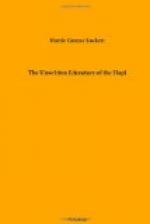A spirit of relief and happiness now pervades the village and everybody keeps open house.
Far more often than otherwise, rain, either a sprinkle or a downpour, has come during or just at the close of the dance, and the people are thankful and hopeful, for this is often the first rain of the season. The writer has herself stood soaked to the skin by a thunder shower that had been slowly gathering through the sultry afternoon and broke with dramatic effect during the ceremony. The Snake priests were noticeably affected by the incident and danced with actual fanatic frenzy.
Those who habitually attend this ceremony from Flagstaff and Winslow and other points within motoring distance (if there is any motoring distance these days) have long ago learned that they would better start for home immediately following the dance, not waiting for morning, else the dry washes may be running bank high by that time and prevent their getting away.
The writer has counted more than a hundred marooned cars lined up at Old Oraibi or Moencopi Wash, waiting, perhaps another twenty-four hours, for the ordinarily dry wash to become fordable. One will at least be impressed with the idea that the Snake Dance (a movable date set by the priests from the observation of shadows on their sacred rocks) comes just at the breaking of the summer drouth.
The writer has seen in the Snake Dance as many as nine groups of three, all circling the plaza at once. But in recent years the number is smaller, in some villages not more than four, for the old priests are dying off and not every young man who inherits the priesthood upon the death of his maternal uncle (priest) is willing to go on, though there are some novices almost every year. This year (1932) the eleven year old brother of a Hopi girl in the writer’s employ went into his first snake dance, as a gatherer, and his sister (a school girl since six) was as solicitous as the writer whenever it was a rattler that Henry had to gather up. But we both felt that we must keep perfectly still, so our expressions of anxiety were confined to very low whispers. Henry was not bitten and if he had been he would not have died. It is claimed and generally believed that no priest has ever died from snake bite, and indeed they are seldom bitten. During the past twenty years the writer has twice seen a priest bitten by a rattler, once a very old priest and once a boy of fourteen. No attention was paid, and apparently nothing came of it.
Dr. Fewkes, Dr. Hough, and other authorities, in works already referred to, assert that the fangs of the snakes are not removed, nor are the snakes doped, nor “treated” in any way that could possibly render their poison harmless. Nor is it believed that the Hopi have any antidote for snake bite in their emetic or otherwise.
Does their belief make them fearless and likewise immune? Or are they wise in their handling of the snakes, so that danger is reduced to the vanishing point? No one knows.




